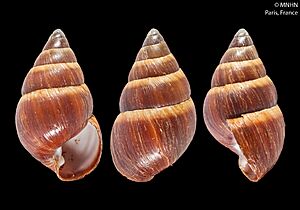Amastra spirizona facts for kids
Quick facts for kids Amastra spirizona |
|
|---|---|
 |
|
| Shell of Amastra spirizona (paralectotype at MNHN, Paris) | |
| Conservation status | |
| Scientific classification | |
| Synonyms | |
|
Amastra spirizona is a special kind of land snail. It's a tiny mollusk that lives on land, belonging to a group called Amastridae. These snails are part of the amazing wildlife found in Hawaii.
Contents
Meet the Amastra Spirizona Snail
This snail is a type of gastropod, which means it's related to slugs and other snails. It moves slowly and carries its home, a shell, on its back.
Different Types of Amastra Spirizona
Scientists have found a few slightly different types of Amastra spirizona. They are like close relatives within the same snail family. These include:
- Amastra spirizona chlorotica
- Amastra spirizona nigrolabris
- Amastra spirizona rudis
What Does Amastra Spirizona Look Like?
The shell of an Amastra spirizona snail can grow up to 18 millimeters long. That's about the size of a small button! Its shell is shaped like a cone and is not see-through. It also has tiny, fine lines or ridges on its surface.
Inside the shell, the snail has a soft body. It has long eyes that stick out and a slightly rough skin texture.
Where Does This Snail Live?
Amastra spirizona is found only in Hawaii. This means it is endemic to these islands. You can find these snails living in trees in the Waianae mountain range. This mountain range is located on the island of Oahu.
They especially like to live on certain plants. These include ekaha ferns, also known as Asplenium nidus. They also enjoy the leaves of ōpuhe plants, which are called Touchardia sandwicensis.
Protecting the Amastra Spirizona
Sadly, the Amastra spirizona snail is in danger. Its population has been shrinking. In 2015, researchers carefully collected 30 snails from their natural home. This was done to help stop their numbers from dropping even more.
These snails face threats from different animals. Rats, other types of snails that eat them, and chameleons all prey on Amastra spirizona. Even though they are in danger, they are not officially listed as endangered by the government.
A group called the Snail Extinction Prevention Program (SEPP) is working hard to save them. They released about 1,200 snails, including Amastra spirizona, into a special safe area. This area is kept free from predators and is carefully looked after by the program.


